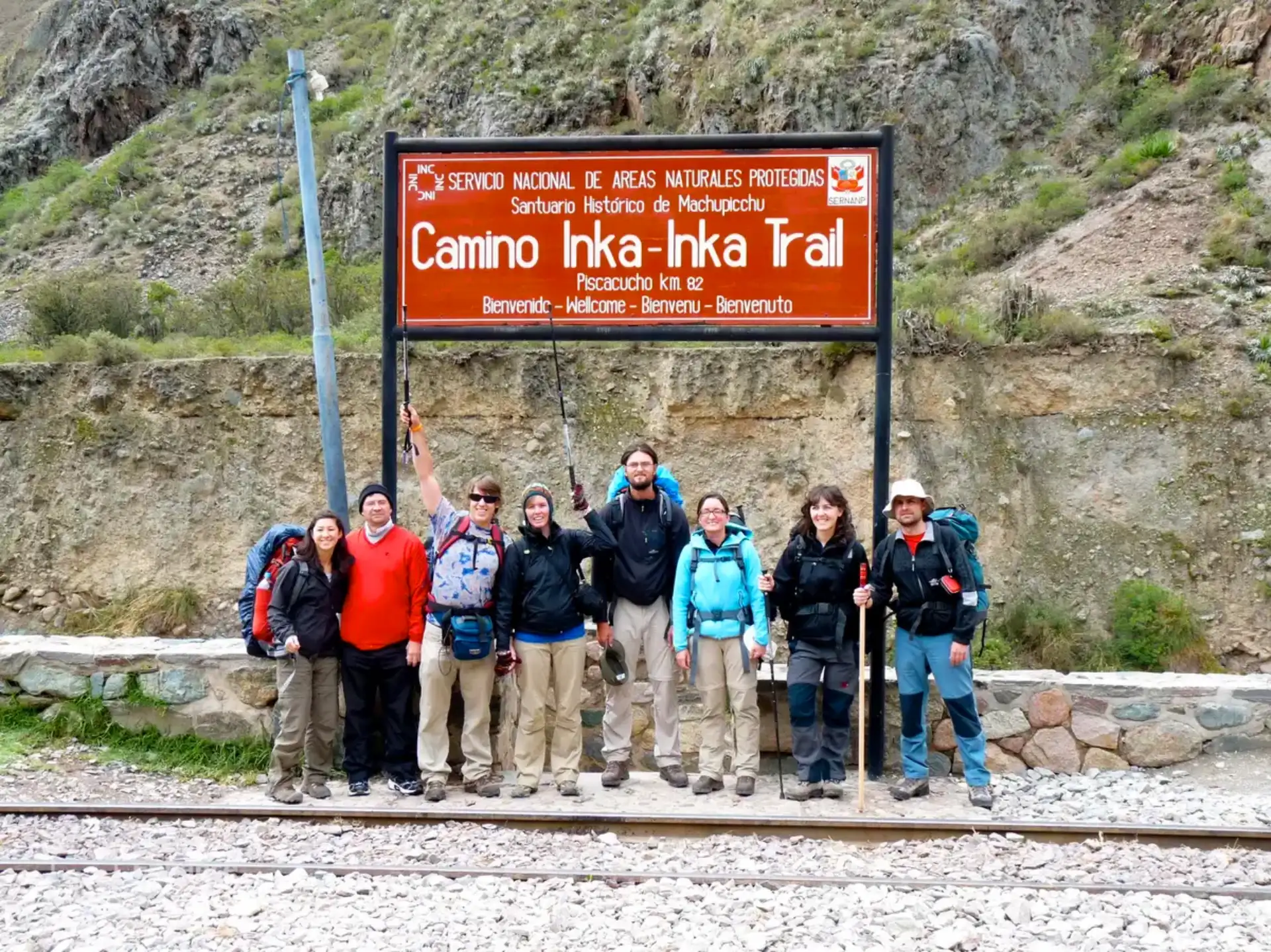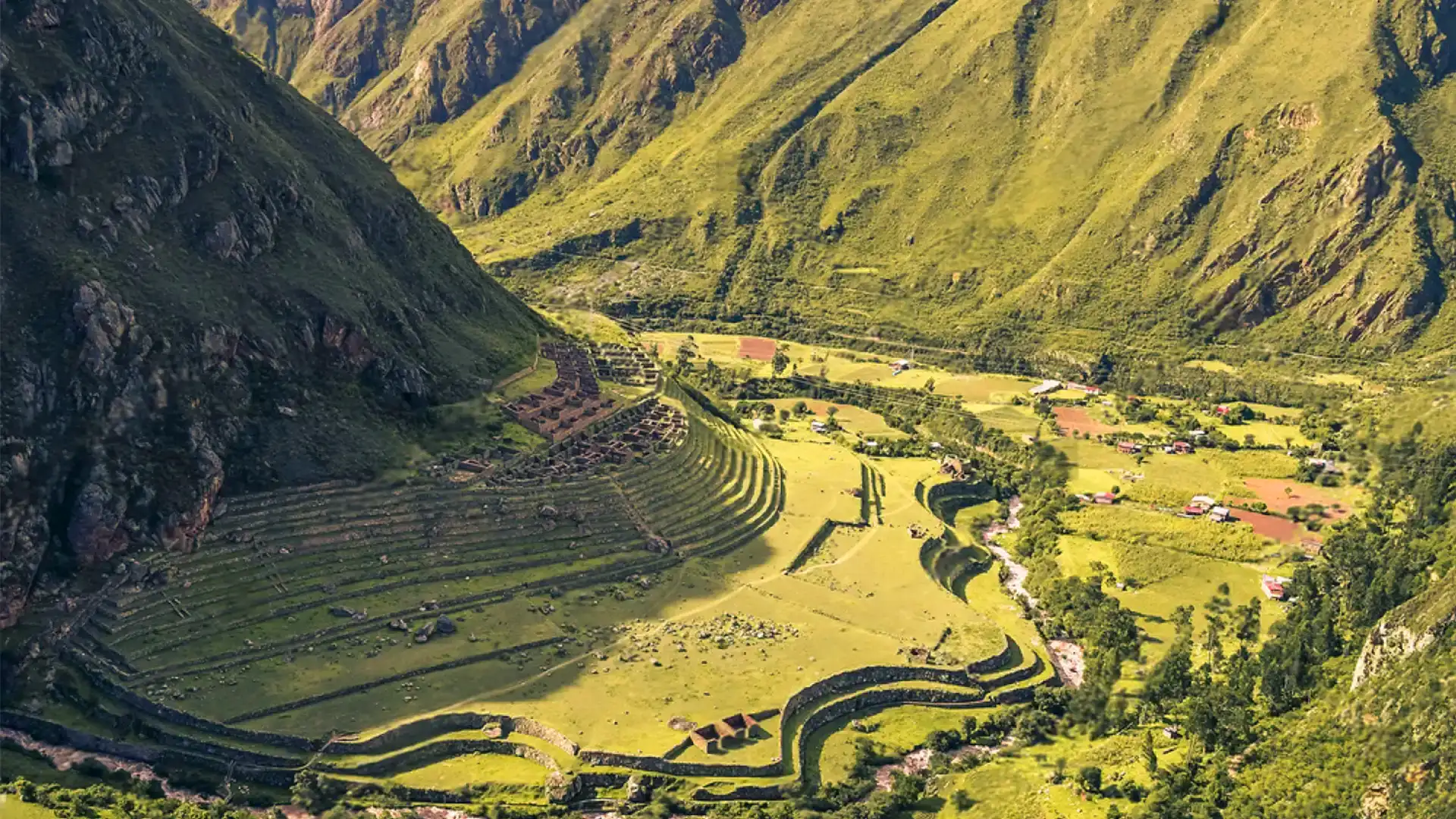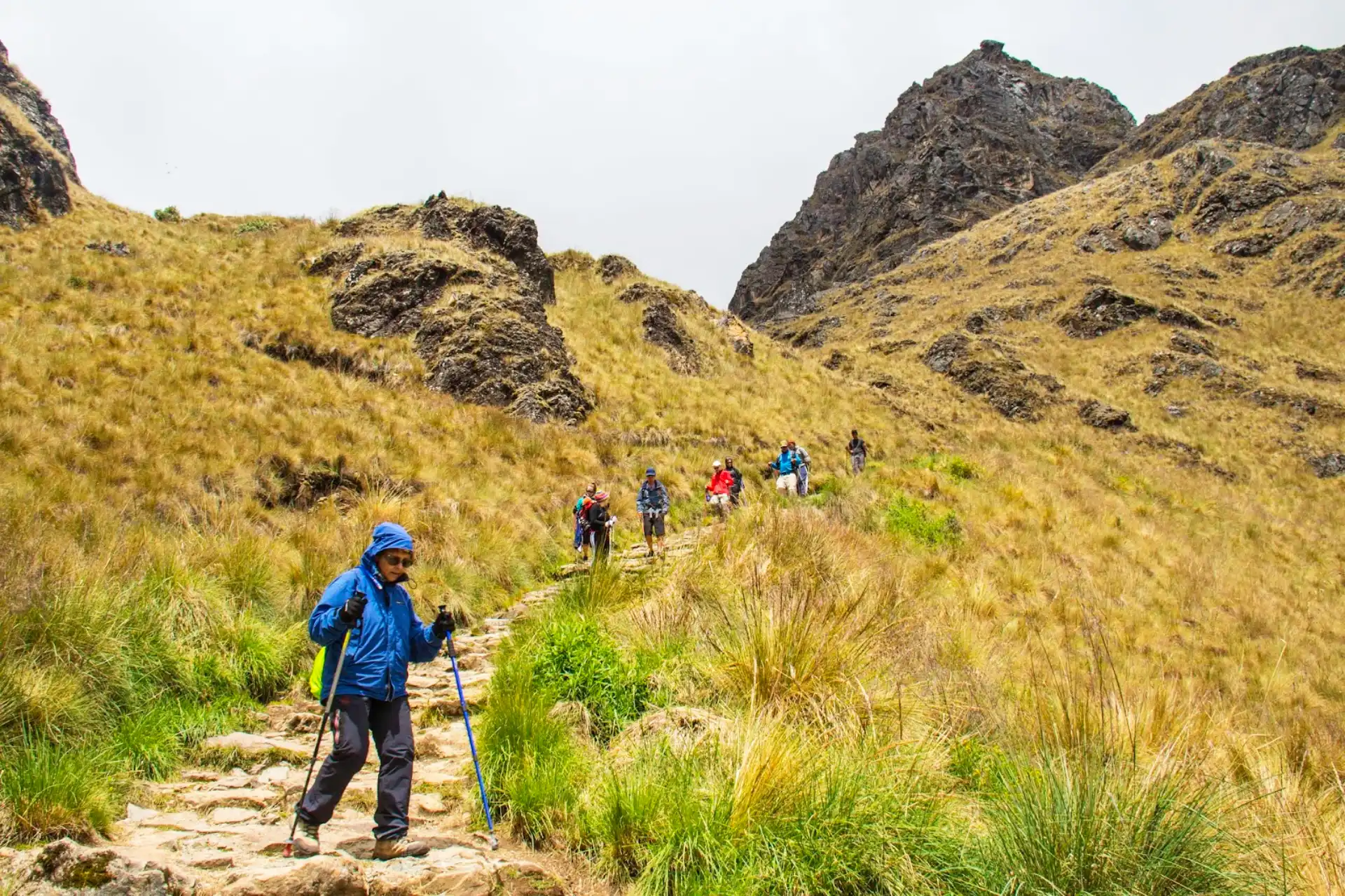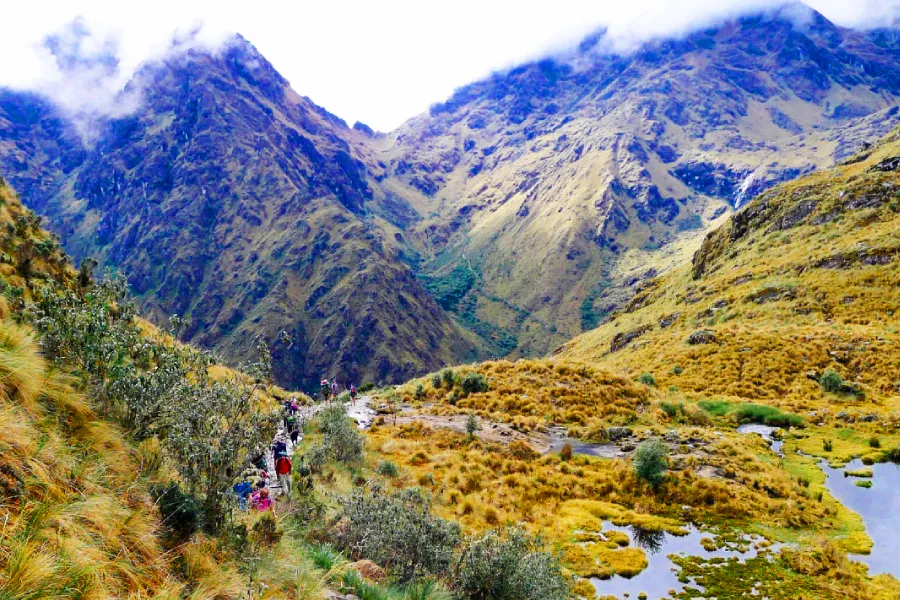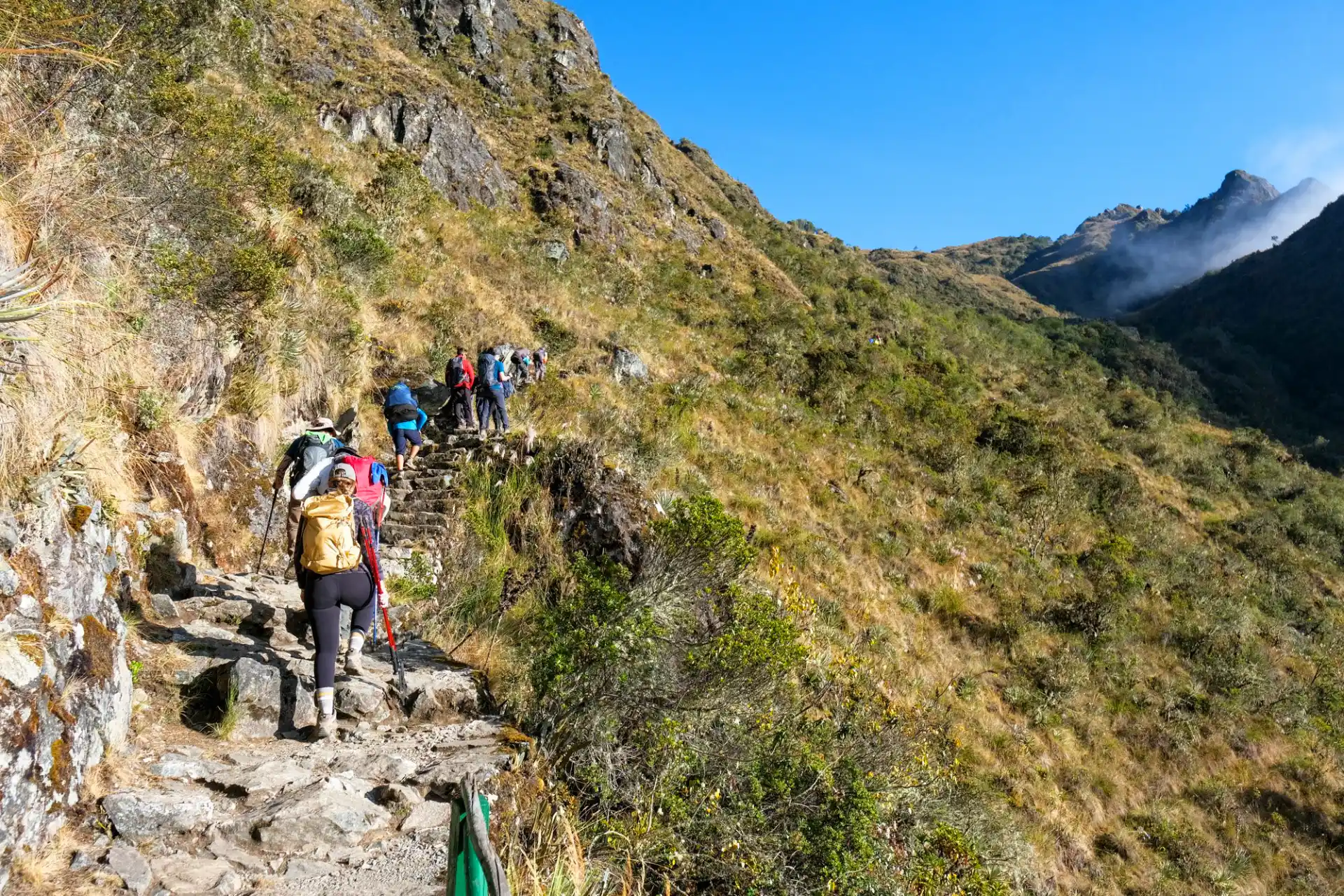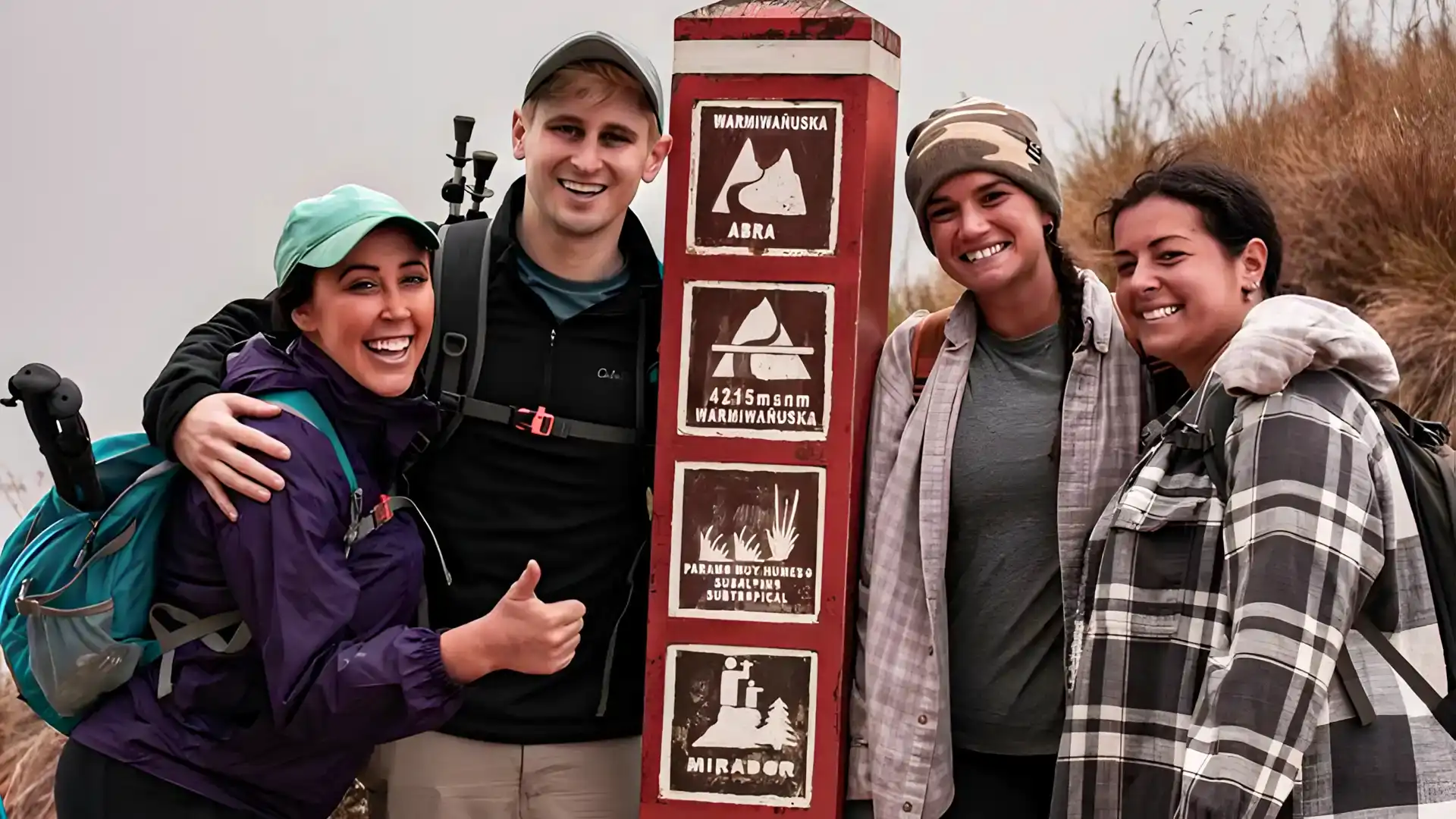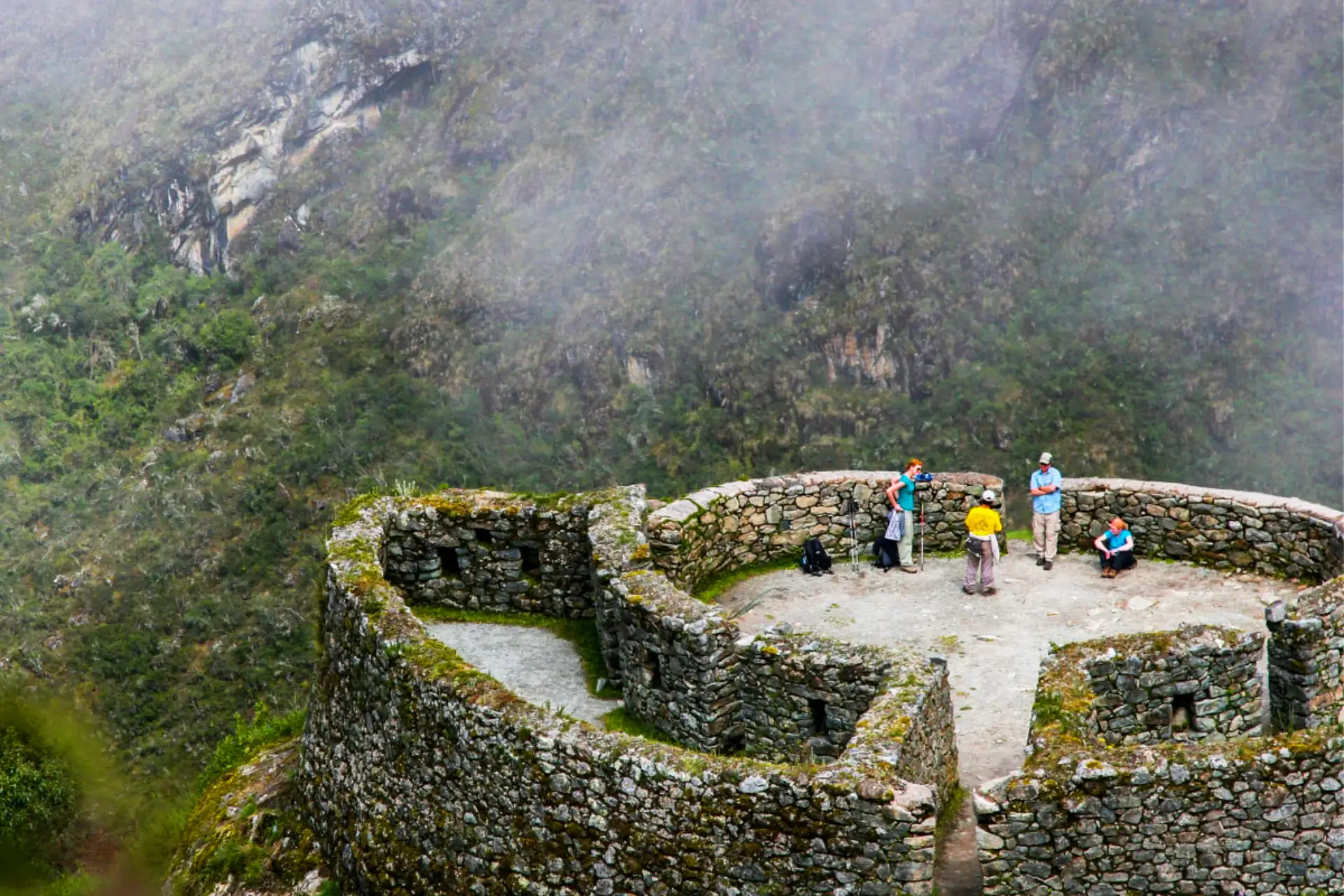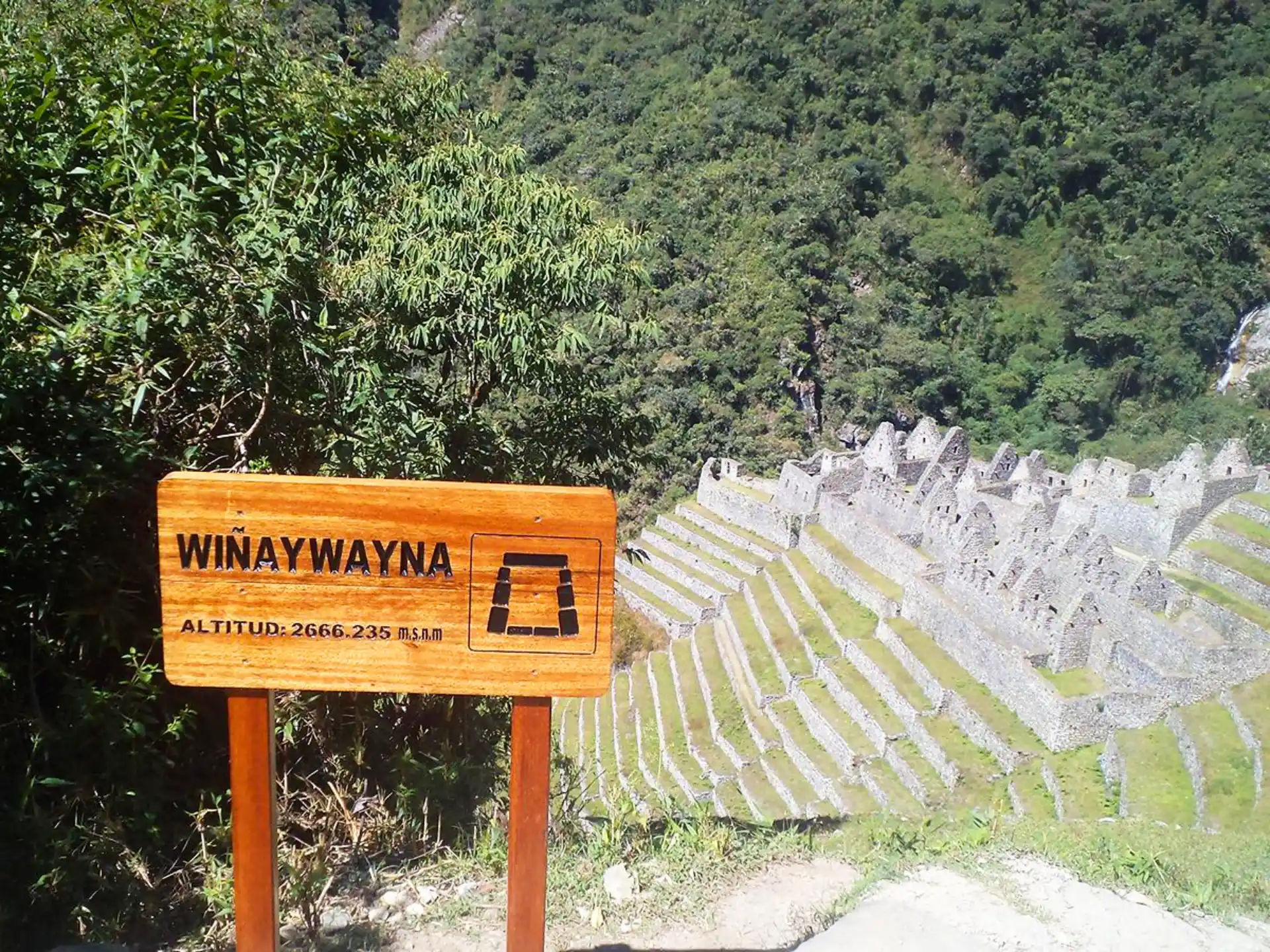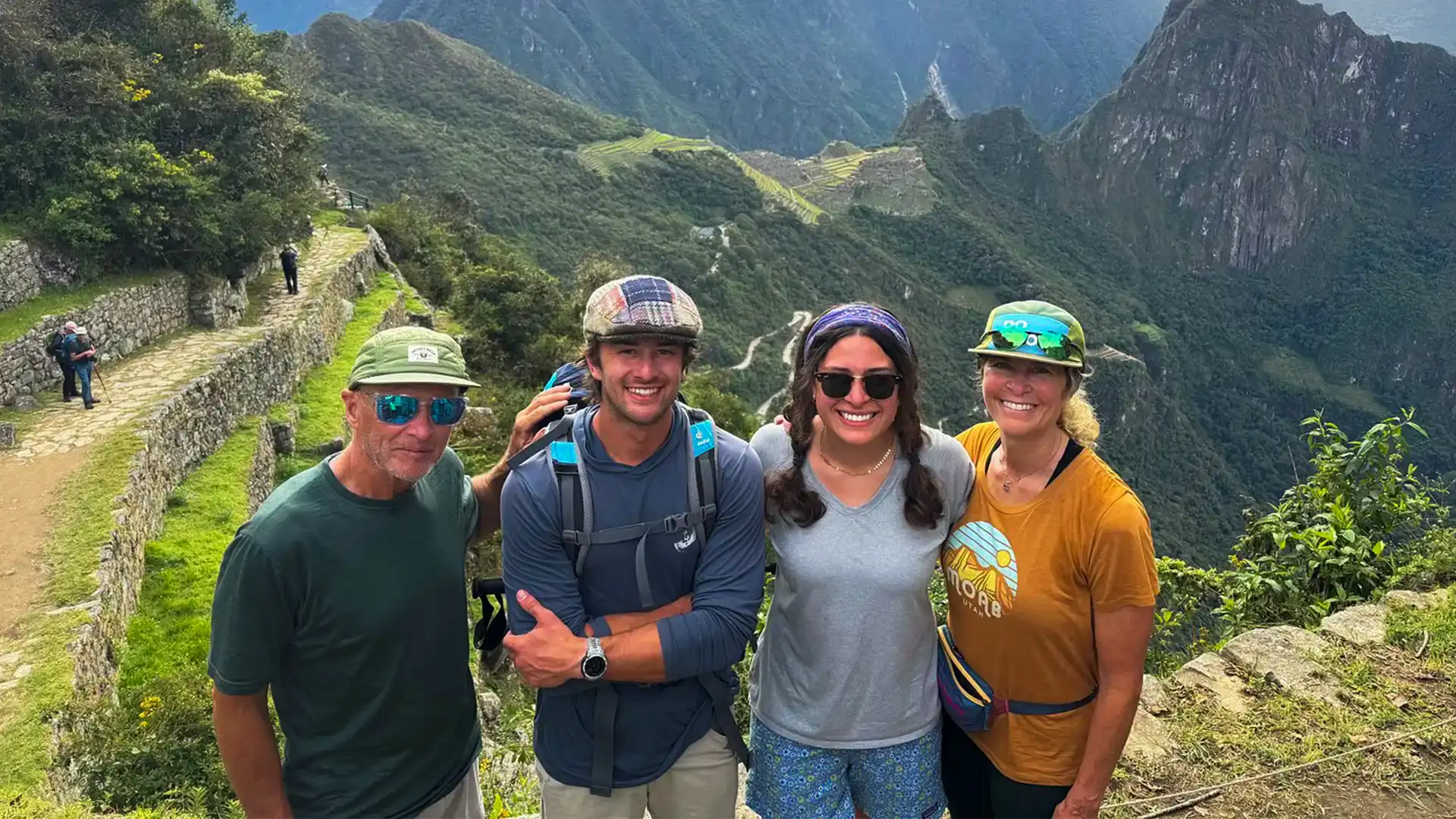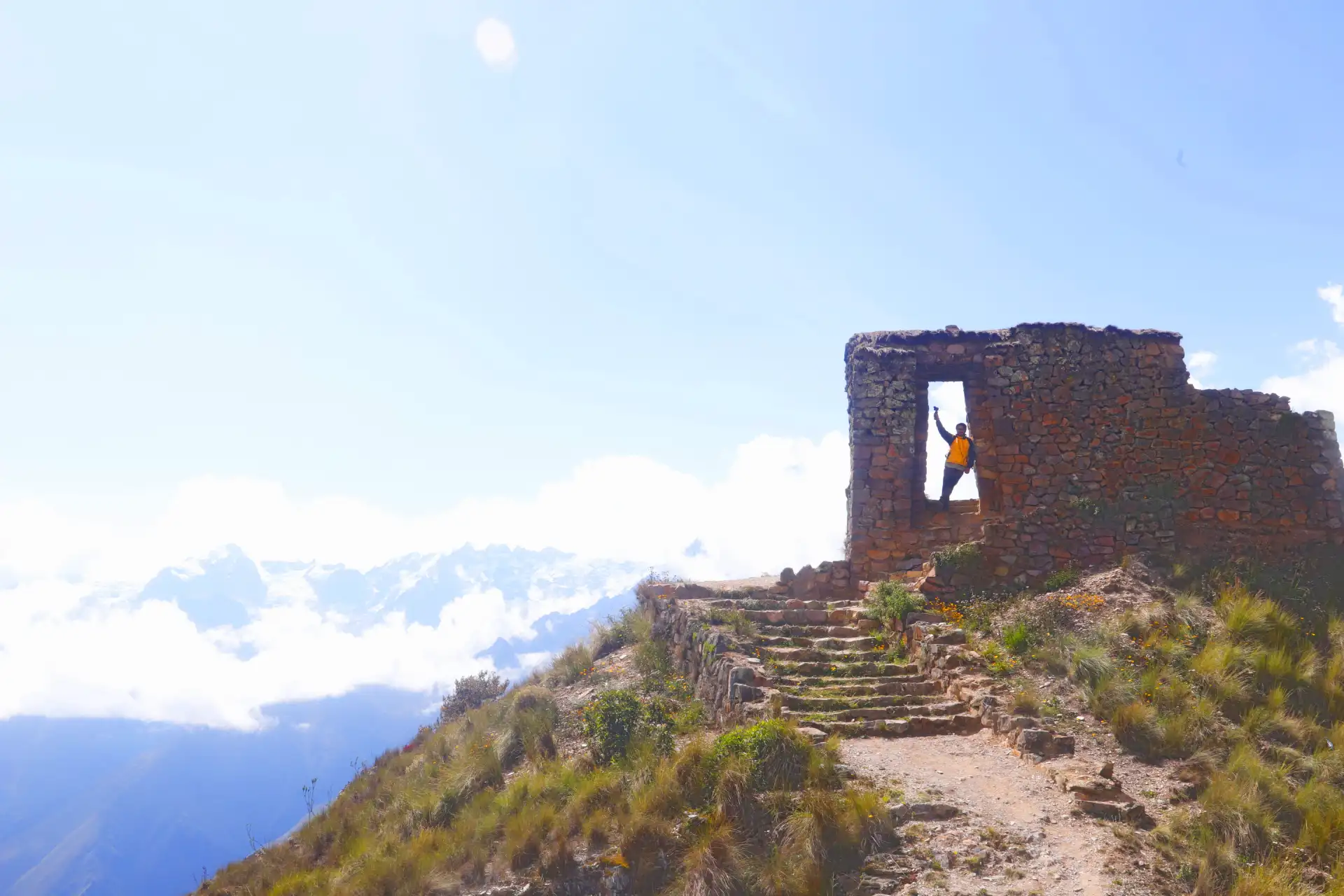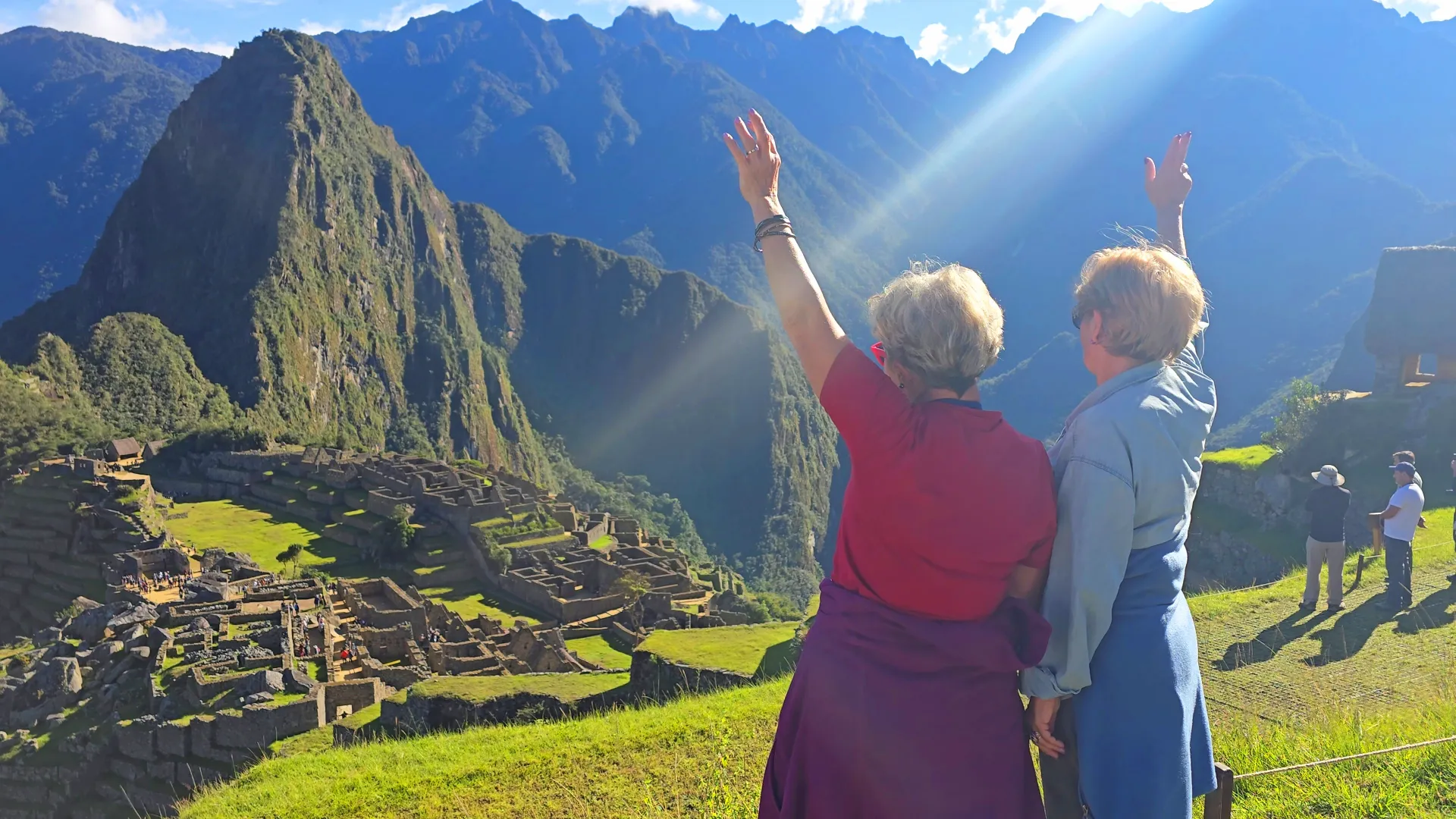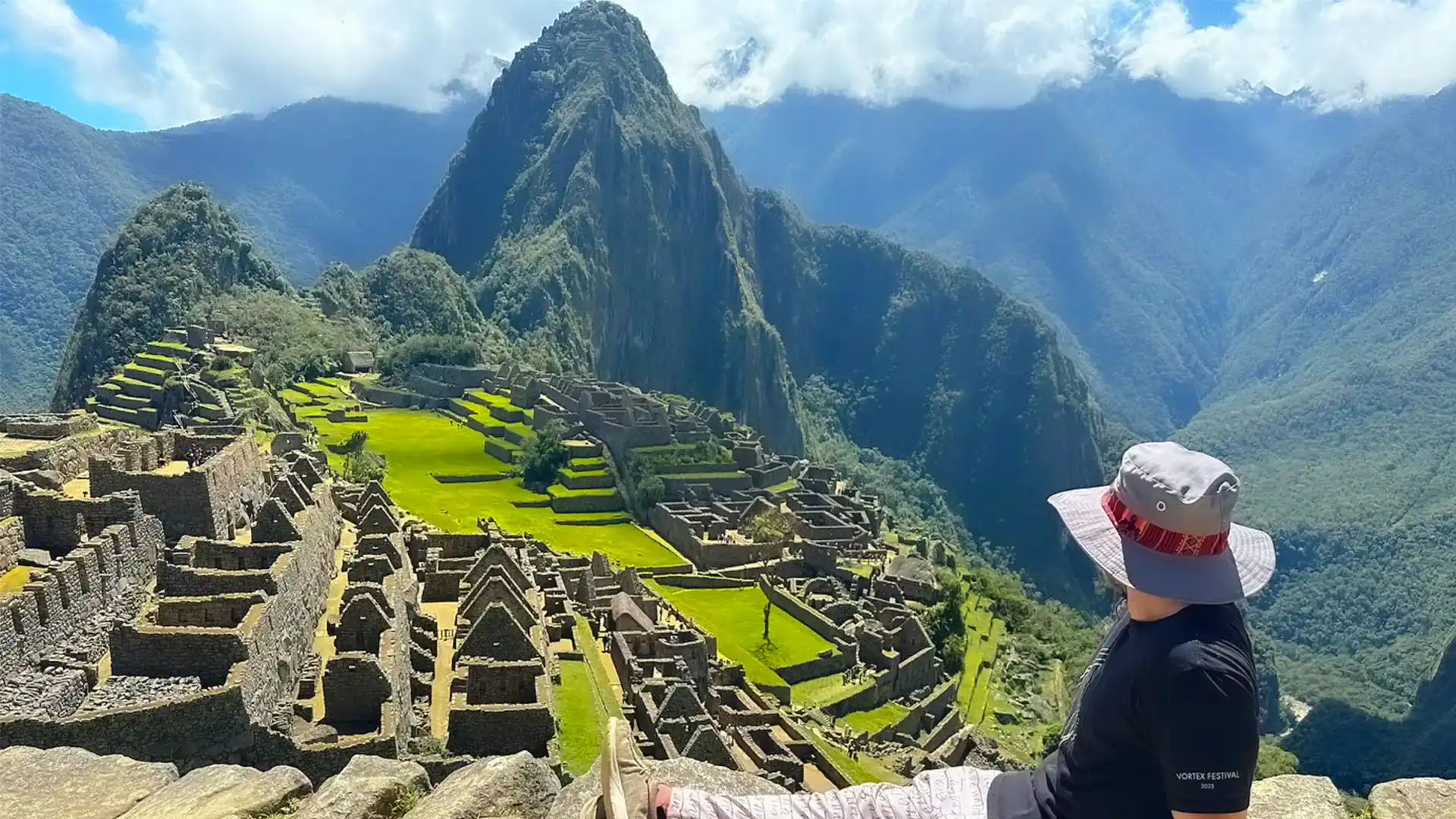Le célèbre Chemin des Incas vous attend, vous offrant quatre jours remplis de paysages à couper le souffle, de merveilles archéologiques cachées et de moments qui resteront gravés dans votre mémoire.
Ce trek emblématique vous mènera à travers des cols de haute montagne, des forêts tropicales luxuriantes et d'anciens sites incas qui ne sont accessibles qu'à pied. Ce n'est pas seulement une randonnée, c'est l'aventure péruvienne ultime, avec des guides experts, des repas délicieux et l'incroyable récompense de voir le soleil se lever sur le Machu Picchu à travers la Porte du Soleil.
Chemin classique des Incas vers le Machu Picchu
Le chemin classique des Incas vers le Machu Picchu est l'une des randonnées les plus inoubliables au monde, alliant aventure, beauté naturelle et histoire riche. Pendant quatre jours, vous marcherez sur les traces des Incas le long d'un ancien sentier qui serpente à travers des paysages montagneux époustouflants, des forêts nuageuses et des sites archéologiques cachés que vous ne pouvez atteindre qu'à pied. À chaque pas, vous serez plongé dans un voyage unique qui allie défi physique et magie des Andes. Le point d'orgue de votre périple sera votre arrivée au Machu Picchu par la Porte du Soleil au lever du soleil, une expérience qui laisse la plupart des voyageurs sans voix. Ce trek est une aventure unique pour ceux qui souhaitent véritablement se connecter à l'esprit de la civilisation inca.
Important : le chemin des Incas est fermé chaque année en février pour entretien. Il est ouvert du 1er mars au 31 janvier.
Le Chemin Inca classique en un coup d'œil
Jour 1 : Cusco - km 82 - Llactapata - Huayllabamba
Commencez votre voyage avec un transfert depuis votre hôtel vers 5 h du matin, en direction du km 82, d'où vous commencerez une randonnée panoramique le long du Chemin de l'Inca. Passez par le site archéologique de Llactapata et continuez à travers la vallée jusqu'à atteindre votre premier campement à Huayllabamba.
Jour 2 : Huayllabamba - Pass de Warmiwañusca - Pacaymayo
Aujourd'hui, après le petit-déjeuner, nous avons commencé une randonnée en montée vers l'Abra de Warmiwañusca, ou « Paso de la Mujer Muerta », le point culminant du sentier (4 200 m d'altitude). Nous descendons ensuite vers la vallée de Pacaymayo où nous campons pour la nuit, entourés des sommets andins.
Jour 3 : Pacaymayo - Runkurakay - Sayacmarca - Puyapatamarca - Wiñay Wayna
Ce jour-là, vous explorerez des sites incas remarquables tels que Runkurakay, Sayacmarca et Puyupatamarca. Après une partie du sentier très pittoresque, vous arriverez à Wiñay Wayna, l'un des endroits les plus beaux et les mieux préservés de l'itinéraire, où vous passerez la nuit.
Jour 4 : Wiñay Wayna - Porte du Soleil (Inti Punku) - Machu Picchu - Cusco
Après un petit-déjeuner matinal, vous ferez une courte randonnée jusqu'à la Porte du Soleil pour assister au lever du soleil sur la citadelle du Machu Picchu. Vous profiterez d'une visite guidée de la citadelle avant de retourner à Aguas Calientes et de regagner Cusco en train, puis de prendre votre transfert.
Itinéraire
Jour 1 : Cusco - Km 82 - Llactapata - Huayllabamba
Commencez votre aventure en étant pris en charge à votre hôtel vers 5h00 du matin, puis voyagez en transport privé jusqu'au kilomètre 82 (Piscacucho), point de départ du légendaire Chemin de l'Inca. Après un bref contrôle à l'entrée, vous commencerez une randonnée facile et pittoresque le long d'un sentier qui borde la rivière Urubamba, entouré de champs agricoles et de montagnes imposantes.
Au cours de la randonnée, vous vous arrêterez pour explorer le complexe archéologique de Llactapata (2 840 mètres d'altitude), un ancien centre agricole inca surplombant la vallée, où votre guide vous présentera l'histoire de l'empire inca et son réseau routier.
Après une pause, vous continuerez la visite en suivant la magnifique vallée de la rivière Cusichaca, en passant par de petits villages et des terrasses andines. Au fur et à mesure que vous avancerez, vous remarquerez un changement progressif de la végétation, avec plus d'arbres et d'ombre, qui annonce l'entrée dans la forêt andine.
Après environ 6 à 7 heures de randonnée au total (pauses comprises), vous arriverez au premier campement dans le pittoresque village de Huayllabamba (2 950 mètres d'altitude), où vous pourrez vous reposer, dîner et vous préparer pour l'ascension difficile du pass de Warmiwañusca le lendemain.
Cette première journée est idéale pour s'acclimater, profiter du paysage et se connecter à l'histoire ancienne du sentier.
Jour 2 : Huayllabamba - Pass de Warmiwañusca - Pacaymayo
*Randonnée (selon les conditions météorologiques)
Préparez-vous pour la journée la plus difficile, mais aussi l'une des plus gratifiantes du Chemin de l'Inca. Après un petit-déjeuner copieux au campement de Huayllabamba, nous commencerons une randonnée intense en montée à travers des paysages montagneux et des forêts nuageuses regorgeant de végétation indigène.
À mesure que nous prendrons de l'altitude, les sons de la rivière s'estompent et les imposants Apus (esprits de la montagne) commenceront à nous accompagner tout au long du chemin. Nos efforts seront récompensés lorsque nous atteindrons l'Abra de Warmiwañusca, ou « Paso de la Mujer Muerta », le point culminant du Chemin de l'Inca (4 200 m d'altitude). De là, profitez d'une vue panoramique imprenable sur les montagnes andines et prenez un moment pour célébrer cette grande réussite personnelle.
Après un repos bien mérité au sommet, nous descendrons lentement vers la vallée de Pacaymayo (3 600 m), entourée de montagnes et de nature sauvage. C'est là que vous attendra notre deuxième campement, où vous pourrez vous détendre, dîner sous les étoiles et vous reposer au milieu d'un environnement silencieux et magique, idéal pour renouer avec la nature.
Cette journée, bien que difficile, sera l'une des plus mémorables de tout le parcours, grâce à ses paysages, au défi physique et à la connexion profonde avec les Andes.
- Camp d'altitude : 3 600 m d'altitude.
Jour 3 : Pacaymayo - Runkurakay - Sayacmarca - Puyapatamarca - Wiñay Wayna
Après un petit-déjeuner réconfortant, nous entamons une journée magique où histoire et nature s'entremêlent à chaque pas. La randonnée commence par une ascension modérée vers le site archéologique de Runkurakay, un ancien poste de garde inca de forme semi-circulaire, d'où l'on peut apprécier une vue spectaculaire sur la vallée.
Nous continuons à monter jusqu'au deuxième col du sentier (environ 3 950 m d'altitude), puis descendons vers Sayacmarca, un complexe archéologique spectaculairement situé sur une colline rocheuse, qui semble suspendue entre les nuages. Ce site, dont le nom signifie « village inaccessible », offre une vue sur l'urbanisme sophistiqué des Incas.
Le sentier nous mène ensuite à travers des forêts nuageuses, des tunnels creusés dans la pierre et une végétation dense et luxuriante, jusqu'au troisième et dernier col, Puyupatamarca (le « village au-dessus des nuages »), l'un des points les plus élevés et les plus mystiques de la journée, avec ses terrasses cérémonielles offrant une vue sublime sur les montagnes et, par temps clair, sur le sanctuaire du Machu Picchu au loin.
De là, nous entamons une longue descente pittoresque par des marches incas en pierre jusqu'à Wiñay Wayna (2 650 m d'altitude), considéré par beaucoup comme le plus beau site du Chemin de l'Inca. Son nom signifie « éternellement jeune » et son ensemble de terrasses, de temples et de fontaines cérémonielles, ainsi que sa vue impressionnante sur la vallée, font de cet endroit un véritable trésor caché.
C'est ici que nous passerons notre dernière nuit, dans un campement confortable entouré d'histoire, à quelques heures seulement de la citadelle du Machu Picchu. L'endroit idéal pour se reposer et se préparer pour la grande journée finale.
- Camp d'altitude : 3 600 m d'altitude
Jour 4 : Wiñay Wayna - Porte du Soleil (Inti Punku) - Machu Picchu - Cusco
Pour cette dernière journée passionnante, nous nous levons très tôt, avant l'aube. Après le petit-déjeuner au campement de Wiñay Wayna, nous entamons la dernière randonnée le long d'un sentier ancestral entouré d'une végétation tropicale mystérieuse.
Après environ une heure et demie, nous arrivons à Inti Punku ou « Porte du Soleil », l'accès original au Machu Picchu à l'époque de l'Empire Inca. Depuis ce point privilégié, nous contemplons pour la première fois la citadelle sacrée tandis que la lumière de l'aube la baigne lentement. Un moment magique qui marque l'aboutissement parfait du voyage.
De là, nous descendons doucement jusqu'à entrer dans le Machu Picchu (2 430 m d'altitude), où nous aurons une visite guidée complète d'environ 2 heures à travers les temples, les places, les terrasses agricoles et les enceintes cérémonielles de cette merveille du monde moderne. Notre guide nous fera découvrir l'histoire, la spiritualité et le génie architectural de ce joyau andin.
Après la visite, vous aurez du temps libre pour explorer par vous-même (si vous avez un billet supplémentaire pour Huayna Picchu ou la montagne Machu Picchu, ce serait le moment idéal pour y monter). Enfin, nous descendrons en bus jusqu'à la ville d'Aguas Calientes, où vous pourrez déjeuner et vous reposer avant de prendre le train pour retourner à Ollantaytambo, puis de là, continuer en transport jusqu'à votre hôtel à Cusco.
Une fin inoubliable pour une aventure transformatrice qui vous liera à jamais à l'histoire, à la nature et à l'énergie des Andes.
Inclus
- Réunion d’information la veille du départ, dans nos bureaux.
- Service gratuit de garde de bagages.
- Prise en charge à votre hôtel le matin du départ.
- 3 petits-déjeuners, 3 déjeuners et 3 dîners (options végétariennes disponibles).
- Transport inclus pendant tout le Chemin de l’Inca.
- Grande variété de repas préparés avec des ingrédients locaux.
- Guide professionnel bilingue.
- Cuisiniers et porteurs expérimentés.
- Grande tente, tente à manger et tente-cuisine.
- 3 nuits en camping.
- Porteur personnel pour transporter jusqu’à 7 kg de vos effets personnels.
- Train de retour d’Aguas Calientes à Ollantaytambo (service Vistadome).
- Transport de retour d’Ollantaytambo jusqu’à votre hôtel à Cusco.
- Billet d’entrée pour le Chemin de l’Inca.
- Billet d’entrée pour le Machu Picchu.
- Billet de bus de descente vers Aguas Calientes.
- Téléphones satellites, trousses de premiers secours et bouteille d’oxygène.
- Tente Eureka pour 4 personnes (partagée par 2 voyageurs).
- Toilettes portables.
- Eau potable et collations quotidiennes.
- T-shirt offert pour le Chemin de l’Inca.
- Tous les impôts et frais de réservation inclus.
Non Inclus
- Articles de toilette personnels.
- Sacs de couchage et matelas gonflables (peuvent être loués auprès de nous).
- Bâtons de marche (peuvent être loués auprès de nous).
- Petit-déjeuner du premier jour, déjeuner et dîner du dernier jour.
- Entrée aux bains thermaux d’Aguas Calientes.
- Porteurs supplémentaires (chacun peut transporter jusqu’à 20 kg par personne).
- Billet pour Huayna Picchu ou Montagne Machu Picchu – coût additionnel de 70 USD par personne.
Réservation à l’avance recommandée, au minimum 3 mois avant.
What Should You Bring?
Bagages de base :
- Petit sac à dos (25-30 L) : pour transporter vos affaires pendant les randonnées quotidiennes.
Vêtements appropriés :
- T-shirts à séchage rapide (x2 ou x3)
- T-shirt thermique ou première couche (pour les matins froids)
- Veste imperméable ou poncho de pluie
- Polaire ou veste chaude
- Pantalons de trekking (x2)
- Sous-vêtements thermiques (pour la nuit)
- Chapeau de soleil et bonnet
- Gants (légers)
- Vêtements confortables pour dormir
- Sandales pour se reposer au campement
- Maillot de bain (si vous souhaitez vous rendre aux sources chaudes d'Aguas Calientes)
Chaussures :
- Bottes de randonnée imperméables, déjà utilisées
- Chaussettes de randonnée (plusieurs paires)
Hygiène personnelle :
- Brosse à dents et dentifrice
- Lingettes humides
- Papier toilette
- Savon biodégradable
- Petite serviette
- Crème solaire et baume à lèvres
- Insecticide
- Gel antibactérien
Trousse de premiers secours personnelle :
- Médicaments personnels
- Paracétamol ou ibuprofène
- Comprimés contre le mal de l'altitude (consultez un médecin avant le voyage)
- Pansements ou bandages
- Sels de réhydratation orale
Autres articles essentiels :
- Lampe frontale avec piles de rechange
- Bâtons de randonnée (avec embouts en caoutchouc)
- Bouteille ou gourde réutilisable (minimum 1 litre)
- Comprimés pour purifier l'eau ou filtre personnel (facultatif)
- Appareil photo ou téléphone portable avec une bonne mémoire et une batterie puissante
- Chargeur portable (power bank)
- Passeport original (obligatoire)
- Argent liquide (soles) pour les petites dépenses et les pourboires
Foire Aux Questions
Ce trek est-il adapté à tout le monde ?
Le Chemin de l'Inca est idéal pour les voyageurs en bonne condition physique qui aiment les aventures en plein air. Les enfants de plus de 12 ans habitués à la randonnée sont les bienvenus sous surveillance.
Combien de temps à l'avance dois-je réserver ?
Les permis sont limités. Nous vous recommandons de réserver 5 à 6 mois à l'avance pendant la haute saison (avril-septembre).
Dois-je tout porter moi-même ?
Non, les porteurs transporteront votre sac de couchage et votre matelas. Vous ne portez que votre sac à dos contenant vos effets personnels.
Puis-je escalader le Huayna Picchu ou le Machu Picchu ?
Oui, mais les places sont limitées et doivent être réservées au moins 4 mois à l'avance, moyennant un supplément de 70 USD.
Que faire si j'ai des besoins alimentaires particuliers ?
Nous proposons des options végétariennes, végétaliennes et autres régimes alimentaires particuliers. Il suffit de nous en informer à l'avance lors de la réservation.
Que faire si j'ai un problème de santé ?
Veuillez nous en informer avant de réserver. Il est de votre responsabilité de consulter votre médecin avant de partir en randonnée.
Quel temps dois-je m'attendre pendant le trek ?
Saison sèche (avril-octobre) : journées ensoleillées, nuits froides.
Saison des pluies (novembre-janvier) : matins humides, sentiers boueux. Emportez toujours un imperméable.
Que faire si le Chemin de l'Inca est complet ?
Nous vous proposerons d'autres alternatives de randonnée, telles que le trek du Salkantay ou l'aventure Inca Jungle, qui incluent tous deux le Machu Picchu.
Quelle est la différence entre le permis pour le Chemin de l'Inca et le billet pour le Machu Picchu ?
Permis pour le Chemin de l'Inca : obligatoire pour parcourir le sentier. Il inclut l'entrée au Machu Picchu.
Informations touristiques sur le Chemin de l'Inca vers le Machu Picchu
Conditions d'entrée
- Permis requis : vous ne pouvez entrer qu'avec un permis officiel délivré au nom du passager. Il doit être réservé plusieurs mois à l'avance !
- Passeport valide : vous devez présenter le même passeport que celui utilisé pour la réservation.
Difficulté physique
- Niveau de difficulté : modéré à difficile. Une bonne condition physique et une préparation préalable sont requises.
- Altitude maximale : 4 200 mètres au-dessus du niveau de la mer (col de Warmiwañusca, jour 2).
- Nous recommandons au moins 2 jours d'acclimatation à Cusco avant de commencer.
Climat et saison
- Saison sèche : d'avril à octobre (idéale pour le trekking).
- Saison des pluies : de novembre à mars (le sentier est fermé en février).
- Les températures varient : journées ensoleillées, nuits froides.
Type d'hébergement
- Des camps de tentes sont organisés par l'équipe de randonnée.
- Les tentes, les sacs de couchage et les repas chauds sont fournis.
- Les porteurs vous aident uniquement avec les sacs de couchage et les matelas.
Transport inclus
- Transport de Cusco au km 82 (début de la randonnée).
- Train retour d'Aguas Calientes à Ollantaytambo.
- Transport touristique vers Cusco.
Services pendant le trek
- Guide professionnel bilingue.
- Cuisinier et porteurs.
- Eau bouillie (à partir du deuxième jour), collations et tous les repas inclus.
- Possibilité de louer un sac de couchage pour 25 USD et des bâtons de marche pour 25 USD.
Franchise bagages
- 1 sac à dos (transporté par le passager).
Connectivité
- Pas de réseau mobile ni d'accès Internet pendant la majeure partie du voyage.
- Le Wi-Fi est disponible uniquement à Aguas Calientes (dernier jour).
Espèces
- Emportez des soles en espèces pour les petites dépenses et les pourboires. Il n'y a pas de distributeurs automatiques ni de magasins acceptant les cartes bancaires sur le trajet.
Politique d'annulation et de modification
- Une fois le permis délivré, il n'est ni remboursable ni transférable.
- Le report est soumis à disponibilité et à la réglementation du ministère de la Culture.

